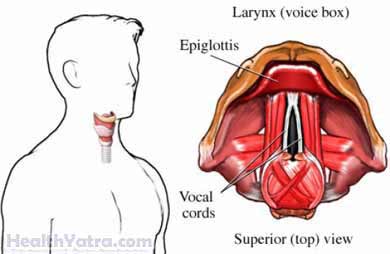Definition
Laryngoscopy is the visual exam of the voice box (larynx) and the vocal cords. There are two main kinds:
Indirect laryngoscopy —uses mirrors to examine the larynx and hypopharynx (a portion of the passageway to the lungs and stomach)
Direct laryngoscopy —uses a special instrument, most often a flexible scope

Reasons for Procedure
Laryngoscopy is used to examine and diagnose problems inside the throat. It is most often done:
- To diagnose the cause of a persistent cough, bloody cough, hoarseness, throat pain, or bad breath
- To evaluate reasons for difficulty swallowing
- To evaluate a possible cause for persistent earache
- To remove a foreign object
- To visualize a mass in the throat
Possible Complications
If you are planning to have a laryngoscopy, your doctor will review a list of possible complications, which may include:
- Pain
- Vomiting and gagging
- Excessive swelling or bleeding
- Cuts on the bottom of the tongue from stretching it over the teeth
- Bleeding from the nose if the scope is passed through the nose
- Anesthesia-related problems
What to Expect
Prior to Procedure
Your doctor may do some of the following:
- Physical exam
- Chest x-ray
- Barium swallow —a series of x-rays of the larynx and esophagus that are taken after drinking a barium-containing liquid
- CT scan —a type of x-ray that uses a computer to make pictures of the inside of the body
Leading up to your procedure:
- Arrange for a ride to and from the procedure if a general anesthetic or sedation is given.
- If you will have general anesthesia, you will probably be told not to eat or drink anything for eight hours before the exam. For office procedures under local anesthesia, there is no need to fast.
Talk to your doctor about your medicines. You may be asked to stop taking some medicines up to one week before the procedure, like:
- Aspirin or other anti-inflammatory drugs
- Blood thinners, such as clopidogrel (Plavix) or warfarin (Coumadin)
Anesthesia
Local or general anesthesia may be used for a laryngoscopy. Local anesthesia will numb the throat. With general anesthesia, you will be asleep.
Description of the Procedure
During either type of laryngoscopy, photographs may be taken.
Indirect Laryngoscopy
You will sit up straight in a high-back chair. A headrest will push your head and jaw forward. The anesthesia will be sprayed into your throat. You will need to gargle it and spit it out. Your tongue will be covered with gauze and held by the doctor. You will then need to breathe through your mouth as if panting. A warm mirror will be held at the back of the throat. The doctor will ask you to make an “eee” sound. The doctor will watch the larynx as you make the noise. If there is a foreign object, such as a chicken bone, it can be removed then.
Direct Fiberoptic Laryngoscopy
The direct method is most often done after the indirect method. The direct method will allow the doctor to see a greater area. The direct method may also be used if your gag reflex did not allow a thorough exam during the indirect method. A special scope will be inserted through your nose or mouth and into your throat. Through an eyepiece on the scope, the doctor will examine the larynx. The doctor may then collect specimens, remove growths, or retrieve a foreign object trapped in the throat. This method is often done in the operating room under general anesthesia or in the office under local anesthesia.
How Long Will It Take?
An indirect laryngoscopy only takes a few minutes. A direct laryngoscopy takes about 5–45 minutes, depending on the problem.
Will It Hurt?
Anesthesia will prevent pain during the procedure. With a direct method, you may have a sore throat for a few days if a biopsy was done.
Postoperative Care
If any tissue was removed, it will be sent to be examined.
Be sure to follow your doctor’s instructions , which may include:
- Do not smoke for 24 hours after the procedure. Smoke irritates the throat.
- Do not try to swallow until your gag reflex returns. Spit out saliva and secretions. The gag reflex should return in about two hours. At this time, throat lozenges or a liquid gargle will help decrease hoarseness and throat irritation. Drinking water is encouraged.
- If a biopsy was taken, avoid clearing your throat or coughing.
The doctor may discuss the results and treatment options or refer you to a specialist. Biopsy results may take about 3-5 days.
Ask your doctor about when it is safe to shower, bathe, or soak in water.
Call Your Doctor
After arriving home, contact your doctor if any of the following occurs:
- Increasing pain
- Coughing up, spitting out, or vomiting blood
- Difficulty breathing or swallowing
- Signs of infection, including fever and chills
- Hoarse voice
- Cough, shortness of breath, chest pain, or severe nausea or vomiting
In case of an emergency, call for medical help right away.
